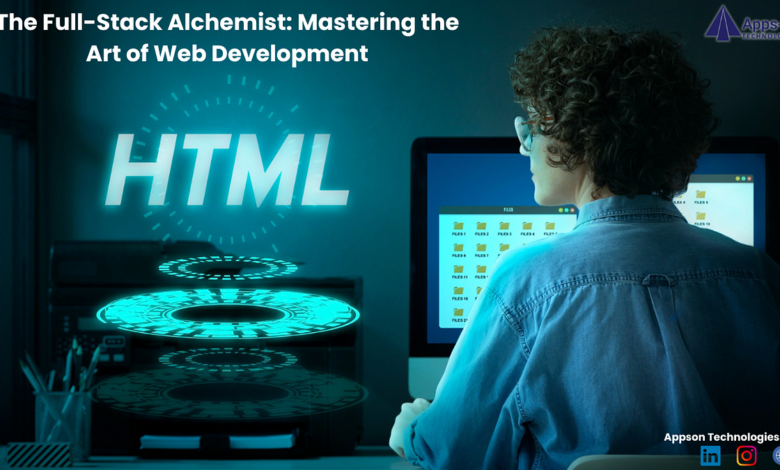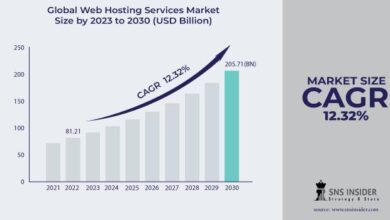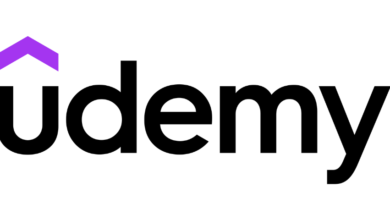The Full-Stack Alchemist: Mastering the Art of Web Development | by Appson Technologies | May, 2024

The internet has become an undeniably central force in our lives. From ordering groceries to connecting with loved ones across the globe, the digital landscape has fundamentally reshaped how we interact with the world. Fueling this ever-evolving realm are the architects of the web: developers. But within this vast community exists a special breed known as the Full-Stack Developer — a true digital alchemist capable of transforming ideas into captivating online experiences.
The Full-Stack Mystique
Unlike their front-end or back-end counterparts, Full-Stack Developers possess a comprehensive understanding of both the visible and invisible forces that power a website or application. They can navigate the intricate workings of the server-side, ensuring data is processed and stored securely, while simultaneously crafting the user-facing interfaces that engage and delight visitors. This ability to seamlessly bridge the front-end and back-end is what sets them apart, making them invaluable assets in the realm of web development.
The Art of the Craft: Essential Skills for the Full-Stack Journey
Becoming a Full-Stack Developer requires a commitment to continuous learning and a mastery of a diverse skillset. Here are some key areas a Full-Stack Alchemist needs to explore:
Front-End Technologies: This encompasses the languages and frameworks that bring websites and applications to life visually. Mastering HTML, CSS, and JavaScript is a foundational requirement. Additionally, popular front-end frameworks like React, Angular, or Vue.js offer structured approaches to building complex user interfaces.
Back-End Technologies: Here’s where the magic happens behind the scenes. Back-end development involves languages like Python, Java, or C#, and frameworks like Django, Spring Boot, or ASP.NET Core used to build the server-side logic, handling data processing, database interactions, and API creation.
Databases: Data is the lifeblood of modern web applications. Full-Stack Developers need to understand various database technologies, such as relational databases (e.g., MySQL, PostgreSQL) or NoSQL databases (e.g., MongoDB) to store and retrieve information efficiently.
Version Control Systems: As projects grow, managing code changes becomes critical. Version control systems like Git allow Full-Stack Developers to track changes, collaborate effectively with team members, and revert to previous versions if needed.
The Benefits of a Full-Stack Approach
The ability to wear multiple hats offers several advantages for both developers and businesses:
Increased Efficiency: Full-Stack Developers can work independently, handling both front-end and back-end tasks, streamlining the development process and reducing reliance on separate specialists.
Improved Communication: Possessing a holistic understanding of the entire development process allows Full-Stack Developers to communicate effectively and collaborate seamlessly with designers, project managers, and other stakeholders.
Greater Control and Flexibility: Full-Stack Developers have a deeper understanding of how all the pieces fit together, enabling them to make informed decisions and adapt to changing requirements more readily.
The Journey Begins: Stepping onto the Path of the Full-Stack Alchemist
The world of web development is vast and ever-evolving. But for those passionate about creating impactful digital experiences, the path of the Full-Stack Developer offers a rewarding and challenging journey. In the next part, we’ll delve deeper into the resources available to aspiring alchemists and explore the exciting world of Full-Stack Development frameworks.
The Alchemist’s Toolkit — Unveiling the Power of Frameworks
In our previous exploration, we unraveled the mystique of the Full-Stack Developer — a master capable of weaving both the front-end and back-end magic that brings websites and applications to life. Now, it’s time to delve into the alchemist’s toolkit: the frameworks that empower Full-Stack Developers to build complex and dynamic web experiences with greater efficiency and maintainability.
Front-End Frameworks: Building User Interfaces with Speed and Structure
Front-end frameworks provide pre-written code libraries and structures that streamline the process of creating user interfaces. Here are some of the most popular choices:
React: Developed by Facebook, React is a powerful and versatile JavaScript library that utilizes a component-based architecture. This allows developers to build complex UIs by composing reusable components, promoting code maintainability and scalability.
Angular: Another popular front-end framework created by Google, Angular offers a more comprehensive and structured approach compared to React. It provides a two-way data binding mechanism, automatically updating the UI when data changes, and vice versa. This makes Angular ideal for building large-scale single-page applications (SPAs).
Vue.js: Often praised for its balance between flexibility and ease of use, Vue.js is a progressively-adoptable JavaScript framework. It offers a core library for building the view layer and allows developers to integrate additional features and functionalities as needed.
Back-End Frameworks: Constructing the Server-Side with Efficiency and Security
While front-end frameworks focus on the user interface, back-end frameworks empower developers to build the server-side logic that handles data processing, business rules, and API creation. Let’s explore some popular options:
Django (Python): This high-level, full-stack framework is known for its rapid development capabilities and clean syntax. Django offers a batteries-included approach, providing most of the functionalities needed to build web applications out of the box.
Spring Boot (Java): Spring Boot is a popular framework built on top of the Spring platform, streamlining the development process for Java applications. It allows developers to focus on writing code without spending time on boilerplate configuration tasks.
ASP.NET Core (C#): Developed by Microsoft, ASP.NET Core is a modern, open-source framework for building web applications using C#. It offers a modular design, allowing developers to choose the specific functionalities needed for their project.
Full-Stack Frameworks: Bridging the Gap for Seamless Development
Beyond dedicated front-end and back-end frameworks, certain options cater specifically to the Full-Stack Developer workflow, integrating both aspects seamlessly:
Ruby on Rails: This popular framework utilizes the Ruby programming language and is renowned for its developer-friendly syntax and convention-over-configuration approach. Ruby on Rails promotes rapid development and is often used for building web applications with complex features.
NestJS: This relatively new framework, built on top of Node.js and TypeScript, offers a modular architecture and strong type checking, leading to improved code maintainability and reduced runtime errors. NestJS provides a familiar API design for developers with experience in Angular, making it an attractive choice for building full-stack applications with JavaScript.
Choosing the Right Tools for the Job: Factors to Consider
The ideal framework selection depends on various factors, including project requirements, team expertise, and personal preferences. Here are some key considerations:
Project complexity: For smaller projects, simpler and more lightweight frameworks might be suitable. For larger and more complex applications, robust and feature-rich frameworks offer greater control and customization.
Team experience: Choosing a framework that aligns with your team’s existing skillset can significantly reduce the learning curve and accelerate development.
Community and resources: A strong community and readily available resources ensure access to support, tutorials, and best practices during the development process.
The Ever-Shifting Sands: Navigating the Evolving Landscape of Full-Stack Development
The realm of web development is a dynamic ecosystem, constantly evolving with new technologies and trends emerging at a rapid pace. As a Full-Stack Alchemist, the ability to adapt and embrace change is paramount. Here’s a glimpse into some of the exciting developments shaping the future of Full-Stack Development:
The Rise of Progressive Web Apps (PWAs): PWAs offer a blend of native app functionality and web-based accessibility. Full-Stack Developers are increasingly incorporating PWA features, allowing users to access applications offline and enjoy a more app-like experience from a website.
The Ascendancy of Cloud Computing: Cloud platforms like AWS, Azure, and Google Cloud Platform (GCP) are transforming how applications are built and deployed. Full-Stack Developers are leveraging the scalability, flexibility, and cost-effectiveness of cloud solutions to build modern and efficient web applications.
The Power of Artificial Intelligence (AI) and Machine Learning (ML): AI and ML are rapidly making their way into web development, opening up new possibilities for user personalization, content recommendation, and even automated code generation. Full-Stack Developers with a grasp of these technologies will be well-positioned for the future.
The Expansion of the Internet of Things (IoT): As more and more devices become connected to the internet, the demand for skillful developers capable of building applications that interact with these devices will surge. Full-Stack Developers with expertise in IoT protocols and data integration will be highly sought after.
The Focus on User Experience (UX) and User Interface (UI): Creating intuitive and visually-appealing interfaces is no longer a luxury but a necessity. Full-Stack Developers are increasingly collaborating with UX/UI designers to ensure their creations are not only functional but also aesthetically pleasing and user-friendly.
Staying Ahead of the Curve: Resources for the Aspiring Alchemist
The journey of a Full-Stack Developer is a continuous learning process. Here are some valuable resources to fuel your growth:
Online Courses and Tutorials: Platforms like Coursera, Udemy, and edX offer a vast array of courses on various Full-Stack Development topics, frameworks, and technologies.
Tech Blogs and Websites: Staying updated with industry trends and best practices is crucial. Subscribing to relevant blogs and websites like DEV Community, freeCodeCamp, and Hacker News can keep you informed of the latest developments.
Open-Source Projects: Contributing to open-source projects is a fantastic way to gain practical experience, build your portfolio, and learn from experienced developers. Platforms like GitHub provide access to a multitude of open-source projects for all skill levels.
Developer Communities and Forums: Engaging with online communities like Stack Overflow allows you to connect with other developers, ask questions, and share your knowledge.
Beyond the Technical: The Soft Skills of a Master Alchemist
While technical proficiency is essential, a successful Full-Stack Developer possesses a blend of soft skills that are equally important:
Problem-Solving and Critical Thinking: The ability to break down complex challenges, analyze solutions, and identify the most efficient approach is vital in developing robust and scalable web applications.
Communication and Collaboration: Full-Stack Developers often work in teams alongside designers, project managers, and other stakeholders. Effective communication and collaboration skills are key to ensuring project success.
Time Management and Organization: Efficient time management ensures tasks are completed within deadlines, and strong organizational skills help keep complex projects on track.
Adaptability and Lifelong Learning: As mentioned, the field of web development is constantly evolving. A willingness to learn new technologies and adapt to changing trends is a hallmark of a successful Full-Stack Developer.
The Alchemist’s Reward: A World of Opportunity Awaits
The path of the Full-Stack Developer is a rewarding journey filled with challenges and opportunities. Having mastered the art of weaving front-end magic with back-end logic, these digital alchemists are in high demand across various industries. Let’s explore the diverse career landscape that awaits them:
A Spectrum of Opportunities: Where Full-Stack Developers Thrive
Tech Startups and Tech Giants: Startups and established tech companies alike actively seek talented Full-Stack Developers to build innovative web applications, internal tools, and user-facing platforms. Working in these dynamic environments offers the chance to be at the forefront of technological innovation and contribute to impactful projects that shape the future.
E-commerce and Retail: The ever-growing e-commerce sector thrives on the expertise of Full-Stack Developers. They are responsible for building and maintaining online storefronts, payment gateways, and secure customer experiences.
Finance and Banking: With the rise of online banking and financial services, Full-Stack Developers are crucial for building secure and reliable financial applications and user interfaces.
Healthcare and Education: The healthcare and education sectors are increasingly leveraging technology to improve service delivery and learning experiences. Full-Stack Developers can contribute to building educational platforms, patient portals, and healthcare management systems.
Freelancing and Independent Consulting: For those seeking autonomy and flexibility, the freelance market offers a wealth of opportunities for Full-Stack Developers. They can work with various clients on diverse projects, building a diverse portfolio and setting their own rates.
The Alchemist’s Compensation: Earning Potential for Full-Stack Developers
Full-Stack Developers are highly sought-after professionals, and their compensation reflects their valuable skillset. According to salary data from various sources, the average salary for Full-Stack Developers in the US can range from $70,000 to $120,000 annually, with factors like experience, location, and industry influencing the pay scale.
Beyond Salary: The Alchemist’s True Rewards
The rewards of being a Full-Stack Developer extend far beyond a competitive salary. Here are some additional benefits that come with the territory:
Job Security: The digital landscape is constantly evolving, and the demand for skilled Full-Stack Developers is projected to remain strong for years to come.
Creative Freedom: Full-Stack Developers have the opportunity to translate ideas into tangible digital experiences. They can apply their creativity and problem-solving skills to build innovative solutions that impact users.
Continuous Learning: The world of web development is a dynamic field, encouraging continuous learning and exploration of new technologies. This intellectual challenge keeps the work engaging and allows Full-Stack Developers to stay at the forefront of their field.
The Final Word: A Call to Action
For those passionate about technology and creating impactful online experiences, the path of the Full-Stack Developer offers a rewarding and challenging journey. Embrace the continuous learning, hone your technical and soft skills, and actively engage with the developer community. Remember, the journey itself is just as important as the destination — so grab your metaphorical tools, ignite your passion, and embark on your own adventure as a digital alchemist. The ever-evolving world of web development awaits your contributions!
Appson Technologies



